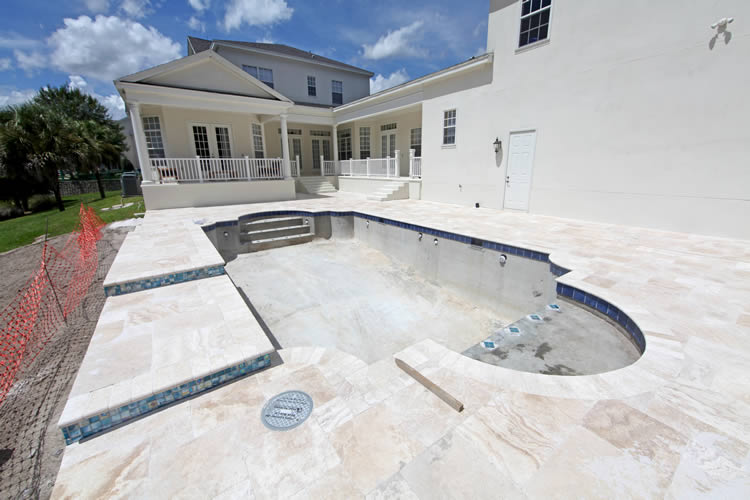Gunite Pool Construction in Metro Atlanta
Building a Gunite Pool That Lasts a Lifetime in Georgia
If you’ve been daydreaming about a backyard pool that feels like a personal resort, there’s a good chance you’re picturing a gunite pool. They’re solid, fully custom, and built to fit your property like it was always meant to be there. At My Aqua Fun Pools, gunite construction is our bread and butter — and the part of the job we love most.
Gunite pools are built from the ground up, literally. It’s a process that takes a little longer than dropping in a fiberglass shell, but what you get in return is durability, flexibility, and an investment that outlasts trends and weather alike. Let’s break down how that happens, step by step.
What Exactly Is a Gunite Pool?
Gunite is a form of concrete sprayed through a high-pressure hose onto a rebar framework. Once cured, it becomes the solid shell of your pool — strong enough to hold up to decades of water pressure, Georgia clay movement, and the occasional summer storm.
Unlike pre-shaped molds, gunite lets us sculpt any shape, depth, or layout you can imagine. Want a tanning ledge, a beach entry, or a built-in spa? We just shape the steel and shoot the concrete. It’s that flexible.
Gunite’s real strength lies in its adaptability. Every yard in North Georgia has its own quirks — red clay, slopes, trees, maybe a tight space beside the deck. Gunite handles all of it without compromise.
Step 1: Planning and Design — From Sketch to Structure
Every build starts with a backyard visit. We look at slope, drainage, and how the pool will relate to your house and yard. Gunite pools can be freeform or geometric, but the goal is always harmony — the pool should look like it belongs.
Once we settle on the footprint, we create a detailed layout and stake it on-site so you can literally walk the outline. Many homeowners find this stage the most exciting — it’s the first time you can see your pool taking shape, even before we dig.
Step 2: Excavation and Steel Reinforcement
North Georgia’s red clay is a blessing and a curse. It’s stable once compacted, but it doesn’t drain well. That’s why excavation is as much an art as a science. We grade carefully, set proper elevations, and install drainage where needed to prevent shifting or hydrostatic pressure later.
After excavation, we install a rebar grid — the skeleton of the pool. Every bar is tied together to form a steel cage that defines the final shape and gives the gunite something to grip onto. This reinforcement is what makes a gunite pool virtually indestructible.
Step 3: The Gunite Application
Now comes the fun part — shooting the gunite. Using a pneumatic hose, we spray a mixture of sand, cement, and water directly onto the steel structure. The nozzleman layers and sculpts it into smooth walls and floors.
It’s loud, dusty work that requires precision and experience. Once the shell cures, it’s as solid as rock. Homeowners are often amazed by how quickly the pool takes recognizable shape at this stage.
Step 4: Plumbing, Tile, and Coping
Before the surface is finished, we install all plumbing lines, drains, returns, and skimmers — everything that makes the pool functional. Then comes tile and coping.
Tile protects the waterline and adds character. Coping — the material that caps the pool’s edge — can be poured concrete, travertine, flagstone, or brick. This is where the pool starts to look designed, not just built.
In Georgia, where freeze-thaw cycles are milder than up north, we have more flexibility with materials, but drainage and sealing are still critical.
Step 5: Plastering and Finishing Touches
The plaster coat (or pebble, or quartz) is the visible surface inside the pool. It’s what you’ll touch, swim against, and see shimmering through the water. This step ties together structure and beauty — durability meets comfort.
We fill the pool immediately after plastering so it cures evenly, then balance the chemistry and start the filtration system. From there, the backyard transitions from construction zone to sanctuary.
The Benefits of Gunite — Built to Last, Designed to Fit
So why do most high-end Georgia pools end up being gunite?
- Durability: Properly maintained, a gunite shell can last half a century.
- Flexibility: Any shape, any size — perfect for custom yards.
- Resale Value: Adds long-term property appeal and equity.
- Repairability: Unlike fiberglass, small issues can be fixed without replacement.
It’s not the cheapest or fastest option, but it’s the most you. Every curve and contour is handcrafted — a reflection of your space and your taste.
Georgia Conditions and Long-Term Care
Gunite does best when paired with balanced chemistry and stable water levels. Our clay-heavy soils mean drainage and decking are just as important as the shell itself. That’s why Aqua Fun builds everything as a system — the pool, the patio, and the grading around it all work together.
Seasonal cleaning, regular brushing, and occasional resurfacing every 10–15 years will keep it beautiful. For most of our customers, that means decades of worry-free ownership.
Wrapping It Up
If you’re comparing pool types, gunite is the one that gives you total creative control and long-term confidence. It’s not just about having a pool — it’s about having your pool. Designed for your yard, your family, and your Georgia lifestyle.
That’s why we still get excited every time we break ground on one. There’s nothing quite like turning a blank backyard into a lifetime of memories.



